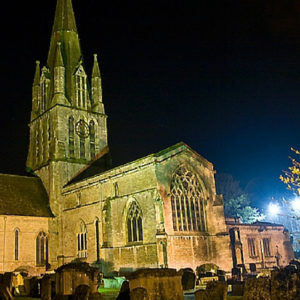St Mary’s Witney 2015
The original pipe organ, at St Mary’s Church, once located in an alcove on the south side of the choir was replaced by a Bradford computing organ in the early 1990s. A project to raise funds to rebuild this organ using current digital organ technology had been started in 2013. However, in 2014 the console interior suffered an electrical fault and the organ was condemned as unsafe. We were asked to provide an estimate to build a new 3 manual digital organ (old one was 2 manual) in the original console. A faculty was issued in late October of 2014 and we began the rebuild shortly before Christmas.
Our rebuilt instrument was installed in early 2015. Apart from an issue with the pedal board, which we had reused from the original instrument, it played perfectly first time. The new console was fitted with new draw stops and new wood based keyboards. 12 new speakers were installed in the old pipe enclosure including two of the original bass cabinets fitted with new long-throw 10 inch drivers. Some of the swell speakers were put at the top of the enclosure and pointed up to the roof to provide a more diffuse radiation of the reed stops. The speakers carrying the new choir division are concealed high behind the chancel alcove arch, in the location of the original pipe organ, so the sound reflects into the choir off the alcove back wall.
To see some more pictures from the installation go to this blog post on the Viscount website.
Listen to three recordings of Dr Joseph Nolan playing the Regent Classic Organ at St Mary’s in Witney below.
1. Widor Symphony No 5 (1st movement):
2. Bach Passacaglia and Fugue in C minor:
3. Bach-Messerer Chaconne:
Francis Rumsey, Organist and ChoirmasterIt’s interesting when preconceptions based on limited experience are shattered. I will freely admit that I hadn’t considered Viscount/Regent as a serious contender for the rebuild of the organ at St Mary’s, so I went to hear one of their recent installations expecting to be disappointed. How wrong could I have been? Walking around the church while its new Physis-based organ was being played rapidly convinced me that it was the system we needed to use. I heard a full, warm sound with remarkable pipe-like realism, and this in a church with only modest reverberation. The physical modelling synthesis allows the sound of each note and stop to change in a subtle way all the time, according to what else is going on, simulated wind pressure changes, and so on, which gives it interest and life. Even up close to the loudspeakers, by the console in that case, where all the warts are usually revealed, it was remarkably good. I felt that I was listening to, and playing, a musical instrument rather than a toy. In a former life I specialised in audio engineering and sound quality perception, so I am not easily pleased. I went back to our church excited and ready to persuade our little organ committee that this was the way we should go.
To cut a long story short, I have been extremely pleased with the process of getting to the point where we have the instrument installed and working in all its glory. David and Jeremy have made the process as painless as possible, and have responded to my many queries in a positive and helpful way. Peter is a genius at doing installations, and nothing is too much trouble. As I am a sound engineer, they let me help them with the calculations to rebuild the bass loudspeakers from our old system, installing modern long-throw drivers that enabled us to get a wonderfully full and extended response right down to the 16 Hz end of the 32 foot pedal stops, while reducing the number of cabinets from three to two. At the last moment I was able to get the console thumb piston spacing amended to the matrix I wanted, as David sent me the drawings before getting the holes drilled. We also got the console height raised slightly to accommodate my knees! All this at a competitive price, I must say.
| Pedal 12 | Great 13 | Swell 12 | Choir 10 | ||||
|---|---|---|---|---|---|---|---|
| Contra Bass | 32 | Double Diapason | 16 | Open Diapason | 8 | Gemshorn | 8 |
| Open Wood | 16 | Open Diapason I | 8 | Gedackt | 8 | Gedackt | 8 |
| Violone | 16 | Open Diapason II | 8 | Viola | 8 | Principal | 4 |
| Bourdon | 16 | Claribel Flute | 8 | Voix Celeste | 8 | Rohr Flute | 4 |
| Octave | 8 | Stopped Diapason | 8 | Principal | 4 | Nazard | 2-2/3 |
| Bass Flute | 8 | Octave | 4 | Stopped Flute | 4 | Octave | 2 |
| Gemshorn | 4 | Harmonic Flute | 4 | Flautino | 2 | Tierce | 1.3/5 |
| Mixture 19 22 26 29 | IV | Twelfth | 2.2/3 | Mixture 15 19 22 26 | IV | Larigot | 1.1/3 |
| Contra Bombarde | 32 | Fifteenth | 2 | Double Trumpet | 16 | Clarinet | 8 |
| Opheclide | 16 | Mixture 19 22 26 29 | IV | Trumpet | 8 | Fanfare Trumpet | 8 |
| Fagott | 16 | Double Trumpet | 16 | Oboe | 8 | ||
| Trumpet | 8 | Trumpet | 8 | Clarion | 4 | ||
| Clarion | 4 | ||||||
| Great to Pedal | Swell to Great | Tremulant | Tremulant | ||||
| Swell to Pedal | Choir to Great | Swell to Choir | |||||
| Choir to Pedal | Gt & Ped Pistons combined | ||||||


